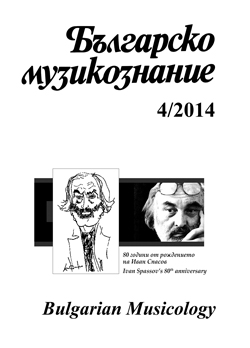Творчество - изпълнителство. Комуникативни модели
Creativity-performance. Communicative models
Author(s): Lilia KrachevaSubject(s): Music
Published by: Институт за изследване на изкуствата, Българска академия на науките
Keywords: music-historical processes; performance; culture and communication; diachronic and synchronic models; auto-communicative model; dialogical model.
Summary/Abstract: Performance in the diversity of its historical practices could be analysed in several aspects: technological, music- historical and social-psychological. The technological aspect comprises the characteristics of singing voices; the structure, technical capabilities and historical development of different types of musical instruments, the ways of handling them (specifics of producing sounds and technical devices, strokes, agogics, etc.); various music and vocal companies. At the same time, in the course of the mu- sic-historical process and with a certain complex of conditions, performative practice plays the role of an important factor in the development of music culture. The social-psychological aspect is based on the fact that it is performative practice that fulfils the communicative function of music art. It shapes its third possible line of research: communicative models in constant interaction take shape in its dynamism. The two major models- auto-communicative model (when the composer and performer are the same person) and dialogical (when they are different persons) are subjected to analysis. The introduced term ‘au- to-communicative model’ is borrowed from Y. Lotman in the field of literature and an attempt has been made to use it in musicology. Special attention is paid also to the specific transitional forms between auto-communication and the dialogical model. The latter is studied in its two major forms, synchronic and diachronic, while the composer-performer dialogue is treated as a dialogue between ages with specific forms of expression. Grounds for the occurrence and development of a secondary (indirect) form of the diachronic dialogical model showing itself in various arrangements, transcriptions and revisions are also given.
Journal: Българско музикознание
- Issue Year: 2014
- Issue No: 4
- Page Range: 55-71
- Page Count: 17
- Content File-PDF

